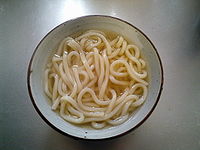
Photo from wikipedia
Abstract: Controlled release of antimicrobial agents is an efficient and promising technology for food preservation. Halloysite nanotubes (HNTs) are a novel material that act as carriers of active agents, while… Click to show full abstract
Abstract: Controlled release of antimicrobial agents is an efficient and promising technology for food preservation. Halloysite nanotubes (HNTs) are a novel material that act as carriers of active agents, while also providing a pathway for sustained release. By using coatings that responded to their environment, we were able to obtain controlled release such that the desired amounts of active agents were delivered to the packaged food at the desired time. In this study, we loaded cinnamaldehyde into HNTs lumen, and used opposite charged polyelectrolytes to cap the ends of the HNTs to control the release of cinnamaldehyde. Fourier transform infrared spectroscopy (FTIR), Brunauer, Emmett, Teller's test (BET) thermogravimetric analysis (TGA), scanning electron microscopy (SEM), transmission electron microscope (TEM), cumulative release rate, and fumigant antibacterial activity were conducted to evaluate the performance of the encapsulated samples. Tube-like morphology of the HNTs, and the location of cinnamaldehyde and polyelectrolytes were identified. The results showed that the stimuli-responsive layer formed by polyelectrolytes exhibited different release rate at different pH values. At higher pH, the polyelectrolytes layer restrained transportation of active molecules, while at lower pH, the coating assisted the release of cinnamaldehyde. Additionally, results of antimicrobial test in vitro illustrated significant fumigant antimicrobial activity of cinnamaldehyde/polyelectrolytes functionalized HNTs. To further learn the preservative effect of samples in food packaging, we conducted a pilot study of packed fresh wheat noodles with the designed nanocomposites, and tested total plate count, pH, color change and environmental-SEM of noodles. Results indicated that the nanocomposites with controlled pH-responsive cinnamaldehyde release is a promising packaging technology for extending the shelf-life of fresh wheat noodles.
Journal Title: Food Control
Year Published: 2022
Link to full text (if available)
Share on Social Media: Sign Up to like & get
recommendations!